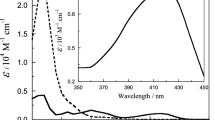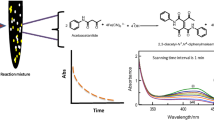Abstract
The redox reaction between hexacyanoferrate(II) ion as the reducing agent and hydrogen peroxide as the oxidizing one, in slightly acid (pH 4.36–6.65) aqueous solutions containing phosphate ions, has been studied by means of an UV–Vis spectrophotometer monitoring the formation of Fe(III) at 420 nm. The initial hydrolysis of the Fe(II)-cyanide complex reactant to yield a pentacyanoaquaferrate(II) intermediate, as well as a decrease in the solution pH (acid catalysis), had both a positive effect on the reaction rate, whereas an increase in the concentrations of Fe(III), phosphate and chloride ions, and d-mannitol had a negative effect (inhibition). A computer program, specifically designed for this purpose, allowed arriving at a complex eight-coefficient experimental rate law by application of the initial rate method, accounting for the dependences of the reaction rate on the concentrations of Fe(II), H2O2 and Fe(III). The reaction was characterized by a low value of the apparent activation energy (28.9 ± 2.7 kJ mol−1). Finally, a multi-step reaction mechanism, involving the participation of a penta-coordinated Fe(II) complex, and hydroxyl, superoxide and other free radicals as intermediates, has been proposed. This mechanism was supported by the available experimental information and confirmed by numerical simulations performed via the fourth order Runge–Kutta integration method.











Similar content being viewed by others
References
Harman D (2006) Free radical theory of aging: an update increasing the functional lifespan. Ann N Y Acad Sci 1067:10–21
Boveris A (1998) Biochemistry of free radicals: from electrons to tissues. Medicina 58:350–356
Valdez LB, Lores Arnaiz S, Bustamante J, Alvarez S, Costa LE, Boveris A (2000) Free radical chemistry in biological systems. Biol Res 3:65–70
Chan PH (2001) Reactive oxygen radicals in signaling and damage in the ischemic brain. J Cereb Blood Flow Metab 21:2–14
Perez-Benito JF (2006) A study of the cytochrome c-hydrogen peroxide reaction. Collect Czech Chem Commun 71:1588–1610
Sohal RS, Weindruch R (1996) Oxidative stress, caloric restriction, and aging. Science 273:59–63
Halliwell B, Gutteridge JMC (2015) Free radicals in biology and medicine. Oxford University Press, Oxford, p 440
Kwak MS, Rhee WJ, Lee YJ, Kim HS, Kim YH, Kwon MK, Shin JS (2021) Reactive oxygen species induce Cys106-mediated anti-parallel HMGB1 dimerization that protects against DNA damage. Redox Biol 40:101858
Ames BN (1983) Dietary carcinogens and anticarcinogens—oxygen radicals and degenerative diseases. Science 221:1256–1264
Cortopassi G, Wang E (1995) Modeling the effects of age-related mtDNA mutation accumulation; complex I deficiency, superoxide and cell death. Biochim Biophys Acta 1271:171–176
Al-Ajlouni AM, Espenson JH, Bakac A (1993) Reaction of hydrogen peroxide with the oxochromium(IV) ion by hydride transfer. Inorg Chem 32:3162–3165
Winterbourn CC (2013) The biological chemistry of hydrogen peroxide. Methods Enzymol 528:3–25
Illes E, Patra SG, Marks V, Mizrahi A, Meyerstein D (2020) The FeII(citrate) Fenton reaction under physiological conditions. J Inorg Biochem 206:111018
Yu Z, Thompson Z, Behnke SL, Fenk KD, Huang D, Shafaat HS, Cowan JA (2020) Metalloglycosidase mimics: oxidative cleavage of saccharides promoted by multinuclear copper complexes under physiological conditions. Inorg Chem 59:11218–11222
Rush JD, Koppenol WH (1986) Oxidizing intermediates in the reaction of ferrous EDTA with hydrogen peroxide. J Biol Chem 261:6730–6733
Rush JD, Koppenol WH (1987) The reaction between ferrous polyaminocarboxylate complexes and hydrogen peroxide: an investigation of the reaction intermediates by stopped flow spectrophotometry. J Inorg Biochem 29:199–215
Rahhal S, Richter HW (1988) Reduction of hydrogen peroxide by the ferrous iron chelate of diethylenetriamine-N, N, N’, N", N"-pentaacetate. J Am Chem Soc 110:3126–3133
Masarwa M, Cohen H, Meyerstein D, Hickman DL, Bakac A, Espenson JH (1988) Reactions of low-valent transition-metal complexes with hydrogen peroxide. Are they “Fenton-like” or not? 1. The case of Cu+aq and Cr2+aq. J Am Chem Soc 110:4293–4297
Yamazaki I, Piette LH (1991) EPR spin-trapping study on the oxidizing species formed in the reaction of the ferrous ion with hydrogen peroxide. J Am Chem Soc 113:7588–7593
Sawyer DT, Kang C, Llobet A, Redman C (1993) Fenton reagents (1:1 FeIILx/HOOH) react via [LxFeIIOOH(BH+)] as hydroxylases (RH → ROH), not as generators of free hydroxyl radicals (HO.). J Am Chem Soc 115:5817–5818
Hage JP, Llobet A, Sawyer DT (1995) Aromatic hydroxylation by Fenton reagents {reactive intermediate [Lx+FeIIIOOH(BH+)], not free hydroxyl radical (HO.)}. Bioorg Med Chem 3:1383–1388
Sawyer DT, Sobkowiak A, Matsushita T (1996) Metal [MLx; M = Fe, Cu Co, Mn]/hydroperoxide-induced activation of dioxygen for the oxygenation of hydrocarbons: oxygenated Fenton chemistry. Acc Chem Res 29:409–416
Kremer ML (1999) Mechanism of the Fenton reaction. Evidence for a new intermediate. Phys Chem Chem Phys 1:3595–3605
Kremer ML (2003) The Fenton reaction. Dependence of the rate on pH. J Phys Chem A 107:1734–1741
Rachmilovich-Calis S, Masarwa A, Meyerstein N, Meyerstein D (2005) The Fenton reaction in aerated aqueous solutions revisited. Eur J Inorg Chem 14:2875–2880
Kremer ML (2017) Strong inhibition of the Fe3+ + H2O2 reaction by ethanol: evidence against the free radical theory. Prog React Kinet Mech 42:397–413
Walling C (1998) Intermediates in the reactions of Fenton type reagents. Acc Chem Res 31:155–157
Marusawa H, Ichikawa K, Narita N, Murakami H, Ito K, Tezuka T (2002) Hydroxyl radical as a strong electrophilic species. Bioorg Med Chem 10:2283–2290
Perez-Benito JF (2004) Iron(III)-hydrogen peroxide reaction: kinetic evidence of a hydroxyl-mediated chain mechanism. J Phys Chem A 108:4853–4858
Perez-Benito JF (2004) Reaction pathways in the decomposition of hydrogen peroxide catalyzed by copper(II). Inorg Biochem 98:430–438
Zeng Q, Wang X, Liu X, Huang L, Hu J, Chu R, Tolic N, Dong H (2020) Mutual interactions between reduced Fe-bearing clay minerals and humic acids under dark, oxygenated conditions: hydroxyl radical generation and humic acid transformation. Environ Sci Technol 54:15013–15023
Sun X, Gu X, Lyu S (2021) The performance of chlorobenzene degradation in groundwater: comparison of hydrogen peroxide, nanoscale calcium peroxide and sodium percarbonate activated with ferrous iron. Water Sci Technol 83:344–357
Chen H, Fang C, Gao X, Jiang G, Wang X, Sun S, Wu W, Wu Z (2021) Sintering- and oxidation-resistant ultrasmall Cu(I)/(II) oxides supported on defect-rich mesoporous alumina microspheres boosting catalytic ozonation. J Colloid Interface Sci 581:964–978
Barb WG, Baxendale JH, George P, Hargrave KR (1955) Reactions of ferrous and ferric ions with hydrogen peroxide. III. Reactions in the presence of 2,2’-bipyridine. Trans Faraday Soc 51:935–946
Walling C, Kurz M, Schugar HJ (1970) The iron(III)-ethylenediaminetetraacetic acid-peroxide system. Inorg Chem 9:931–937
Walling C, Partch RE, Weil T (1975) Kinetics of the descomposition of hydrogen peroxide catalyzed by ferric ethylenediaminetetraacetate complex. Proc Nat Acad Sci 72:140–142
Francis KC, Cummins D, Oakes J (1985) Kinetic and structural investigations of [FeIII(EDTA)]-[EDTA=Ethylenediaminetetra-acetate(4-)] catalysed decomposition of hydrogen peroxide. J Chem Soc Dalton Trans 3:493–501
Amina, Si X, Wu K, Si Y, Yousaf B (2018) Synergistic effects and mechanisms of hydroxyl radical-mediated oxidative degradation of sulfamethoxazole by Fe(II)-EDTA catalyzed calcium peroxide: implications for remediation of antibiotic-contaminated water. Chem Eng J 353:80–91
Bray DG, Thompson RC (1994) Trace metal ion catalysis in the oxidation of Fe(CN)64- by H2O2. Inorg Chem 33:905–909
Davies G, Garafalo AR (1976) Stoichiometry and kinetics of the substitution-controlled oxidation of pentacyanoaquoiron(II) species by hydrogen peroxide and by tert-butyl hydroperoxide in aqueous sodium perchlorate solution. Inorg Chem 15:1101–1106
Karunakaran C, Muthukumaran B (1996) Kinetic evidence for peroxo complex formation in perborate or hydrogen peroxide oxidation of hexacyanoferrate(II). Pol J Chem 70:79–82
Kislenko VN, Oliinyk LP (2003) Kinetics of hydrogen peroxide decomposition in guaiacol solution, catalyzed by hexacyanoferrate(II). Russ J Gen Chem 73:114–118
Rabai G (1991) pH oscillation in the closed system of H2O2-[Fe(CN)6]4−-acetonitrile water. J Chem Soc Chem Commun 16:1083–1084
Katafias A, Impert O, Kita P (2008) Hydrogen peroxide as a reductant of hexacyanoferrate(III) in alkaline solutions: kinetic studies. Transition Met Chem 33:1041–1046
Baxendale JH (1952) Decomposition of hydrogen peroxide by catalysts in homogeneous aqueous solution. Adv Catal 4:31–86
Domingo PI, Garcia B, Leal JM (1989) Acid-base behaviour of the ferricyanide ion in perchloric acid media. Spectrophotometric and kinetic study. Can J Chem 68:228–235
Perez-Benito JF, Arias C, Amat E (1995) A kinetic study of the reactions of cisplatin with biological thiols. New J Chem 19:1089–1094
Laidler KJ (1987) Chemical kinetics. Harper Collins, New York, p 30
Beck MT (1987) Critical survey of stability constants of cyano complexes. Pure Appl Chem 59:1703–1720
Kuhn DD, Young TC (2005) Photolytic degradation of hexacyanoferrate(II) in aqueous media: the determination of the degradation kinetics. Chemosphere 60:1222–1230
Bell S, Foster G, Fuller MW, Hughes D, Le Brocq KMF, Leslie E, Wilson IR (1986) Spectrophotometric measurement of rates of hexacyanoferrate(III) reactions. Int J Chem Kinet 18:651–653
Perez-Benito JF, Arias C, Brillas E (1990) Comment on monitoring of hexacyanoferrate(III) reactions by spectrophotometric methods. Int J Chem Kinet 22:95–97
Bruice PY (2016) Organic chemistry. Pearson, Upper Saddle River, New Jersey, p 404
Luo L, Yao Y, Gong F, Huang ZF, Lu WY, Chen WX, Zhang L (2016) Drastic enhancement on Fenton oxidation of organic contaminants by accelerating Fe(II)/Fe(III) cycle with L-cysteine. RSC Adv 6:47661–47668
Behar D (1974) Pulse radiolysis study of aqueous hydrogen cyanide and cyanide solutions. J Phys Chem 78:2660–2663
Wilkinson F (1980) Chemical kinetics and reaction mechanisms. Van Nostrand Reinhold, New York, pp 42–44
Perez-Benito JF (2017) Some considerations on the fundamentals of chemical kinetics: steady state, quasi-equilibrium, and transition state theory. J Chem Educ 94:1238–1246
Wang J, Wang S (2021) Effect of inorganic anions on the performance of advanced oxidation processes for degradation of organic contaminants. Chem Eng J 411:128392
Han M, Jafarikojour M, Hamachi M, Mohseni M (2021) The impact of chloride and chlorine radical on nitrite formation during vacuum photolysis of water. Sci Total Environ 760:143325
Xu HB, Zhu YP, Cui DJ, Du MR, Wang JQ, Ma RN, Jiao Z (2019) Evaluating the roles of OH radicals, H2O2, ORP and pH in the inactivation of yeast on a tissue model by surface micro-discharge plasma. J Phys D 52:395201
Krewing M, Schubert B, Bandow JE (2020) A dielectric barrier discharge plasma degrades proteins to peptides by cleaving the peptide bond. Plasma Chem Plasma Process 40:685–696
Espenson JH (1995) Chemical kinetics and reaction mechanisms. McGraw-Hill, New York, pp 113–115
Author information
Authors and Affiliations
Corresponding author
Additional information
Publisher's Note
Springer Nature remains neutral with regard to jurisdictional claims in published maps and institutional affiliations.
Rights and permissions
About this article
Cite this article
Perez-Benito, J.F., Pages-Rebull, J. Oxidation of hexacyanoferrate(II) ion by hydrogen peroxide: evidence of free radical intermediacy. Reac Kinet Mech Cat 133, 631–653 (2021). https://doi.org/10.1007/s11144-021-02026-4
Received:
Accepted:
Published:
Issue Date:
DOI: https://doi.org/10.1007/s11144-021-02026-4




